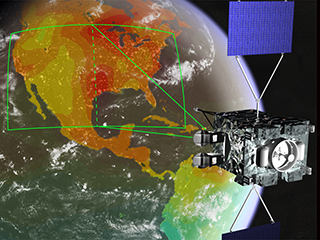How Satellite Technology is Transforming Climate Action
by Bogdan Gogulan, Managing Director of NewSpace Capital
Luxembourg City, August 29, 2024--Wildfire season is upon us, and due to global warming, we can anticipate one of the worst on record. Canada, which is training extra firefighters, warns of an ‘explosive’ season. Greece is doubling its firefighting crew and adopting new tactics. Portugal has banned bonfires, barbecues, and the use of machinery that can trigger sparks, such as chainsaws and trimmers. And it isn’t just wildfires that are cause for concern. The risk of massive floods in cities like New York, Shanghai and Kolkata increases each year. Summers get hotter, winters get colder. Hurricanes and cyclones get stronger – and more destructive.
But we’re not passive players in the climate crisis. With each passing year, entrepreneurs and innovators dream up new tools and technologies or build on existing ones with the potential to make a meaningful difference on our warming planet. More and more, these tools and technologies appear in the space sector, which is already playing an outsized role across countless industries around the world.
Bringing down emissions
We know that a major reason why the planet is heating up is because of greenhouse gas emissions, with carbon dioxide being the most widely known. For the time being, machinery and vehicles that run on fossil fuels – and therefore emit CO2, will continue to be used; but the more efficiently they run, the less fuel they need, and less CO2 they contribute.
 |
| (image courtesy of NASA) |
Satellites are currently bringing down CO2 emissions globally by the equivalent of nearly four times what the entire UK put out in 2021. That’s 1.5 billion tonnes – and that doesn’t scratch the surface of what satellites could do if used fully. The research firm Globant calculated that if only existing satellite technology was deployed to its greatest potential, we can save an additional 4 billion tonnes of CO2. The 5.5 billion tonnes of carbon dioxide saved if this were to happen would amount to one-sixth of the total carbon emissions needed to limit the rise in global temperature to below 1.5°C by 2030.
Carbon dioxide isn’t the only GHG of concern; methane also poses a significant problem with a much greater short-term climate impact. Satellite technology is aiding in reducing methane emissions by providing reliable data from third-party companies mapping global methane emissions. With accurate, verifiable information, policymakers can address methane leaks, penalise offenders, and enforce new policies. In the US, companies now face hefty fines for excess methane emissions, made possible by satellite data.
Predicting, preventing and putting out fires
As I’ve already mentioned, countries around the world are steeling themselves for wildfire season. They’re wise to do so: wildfires are getting worse, emitting around 8 billion tonnes of CO2 per year, according to the International Energy Agency. Accounting for CO2 offsetting, that amounts to annual net emissions of between 5% and 10% of all CO2 emissions globally.
The cost of wildfires is financial, too. The total cost of wildfires in the United States is between US$ 394 billion to US$ 893 billion each year – which is equivalent to between 2 and 4% of U.S. GDP. This is spread across diminished real estate values, lost income, damage to watersheds and aquifers, insurance payouts, timber loss, property and infrastructure damage, electricity costs, evacuation costs, federal wildfire suppression costs, school and learning losses related to wildfires, insurance premium increases, and tourism loss.
Space-enabled technology is helping. By tracking forests through various metrics—vegetation density, rainfall, and wind patterns—companies use satellites to analyse past wildfires and predict future ones, identifying potential breakouts and at-risk assets. This benefits individuals, companies, and emergency services, enabling more effective responses and saving lives and money.
Healing the world’s lungs
If we reflect on the past, it’s easy to see what a vital role forests play in maintaining stable global temperatures. For over 10,000 years, due largely to the robust health of the natural world, average temperatures remained within the one-degree Celsius range. Throughout this period, dense equatorial jungles layered plants to absorb sunlight, contributing moisture and oxygen to the air worldwide.
To restore equilibrium, we must turn our attention to our forests. Rainforests, in particular, capture carbon dioxide and cool the planet down, all while supporting the livelihoods of billions and being home to more than three-quarters of the world’s biodiversity. By bouncing signals off the rainforest canopy, satellites are able to monitor the height of trees, reveal illegal deforestation, and track the progress of reforestation initiatives with rising accuracy.
This, in turn, is helping us to understand whether carbon projects are working, and therefore put trust back into the carbon market – now widely seen as essential to facilitating the movement of financial resources from companies in the Global North to protectors of the world’s rainforests in the Global South. A functioning carbon credit market could be worth more than $50 billion. Thanks to satellites, that looks increasingly likely.
Producing food and improving farming
Agriculture finds itself in the unusual position of being projected to eat up some 70% of our GHG emissions budget by 2050 while failing to produce enough food for the world’s population to eat. A US$ 7.8 Trillion global market that employs 40% of the world’s workforce, agriculture still left around 2.3 billion people moderately or severely food insecure in 2010, the WHO found, with a 56% gap between food needed and food produced expected to appear in 2050. Agricultural practices also lead to soil erosion and a 60% loss of organic carbon from the soil. Increasing productivity, optimising yields and boosting overall sustainability is a pressing need.
Satellites are beginning to do this. They’re tackling waste throughout the supply chain and using digital agronomy tech for precision farming and natural capital management. They’re helping farmers to estimate and optimise yields, increase soil quality, and use only the water and fertilise they need for the best results. Satellites are involved in pest detection, which could save up to 0.8 billion tonnes of crops annually, and irrigation, reducing water usage by up to 50%. That’s the equivalent to saving up to 2.8 billion litres of freshwater.
A byproduct of this, according to the UN Food and Agriculture Organization, is savings in the region of $175 billion for producers. It’s no surprise that McKinsey & Company predicts the market for space-enabled insights in agriculture will double by 2030, hitting almost US$ 1 Billion.
Better quality, lower costs
Satellites are transforming climate action.
They’re giving humanity a powerful means to confront the challenge of the warming planet and come out on top. There is a long way to go, of course, but satellite technology is improving all the time, empowering individuals, companies, countries and global institutions to make the right choices. Better yet, as the technology improves, costs are also going down. That gives us every reason to be optimistic. Thanks to the ingenuity of those working in the space tech sector, we have more than a fighting chance of resolving what, many agree, is one of humanity’s greatest ever challenges.
--------------------------------------
 Bogdan Gogulan has 20 years of experience in finance, product and business development. Before initiating NewSpace Capital, he had accumulated a unique combination of cross-border experience in communication, security and defence industries. He served as VP of international operations and business development for AT Communication (Switzerland), Defendec (Baltics) and Katmerciler (Turkey), managing breakthrough projects for security and defence agencies in the Middle East and Central Asia. For years, he managed alignment and cooperation with UN agencies (BOMCA/UNDP, BOMNAF, UNODC, UNHCR, IOM) and security organisations (NATO, OSCE, ISAF).
Bogdan Gogulan has 20 years of experience in finance, product and business development. Before initiating NewSpace Capital, he had accumulated a unique combination of cross-border experience in communication, security and defence industries. He served as VP of international operations and business development for AT Communication (Switzerland), Defendec (Baltics) and Katmerciler (Turkey), managing breakthrough projects for security and defence agencies in the Middle East and Central Asia. For years, he managed alignment and cooperation with UN agencies (BOMCA/UNDP, BOMNAF, UNODC, UNHCR, IOM) and security organisations (NATO, OSCE, ISAF).





